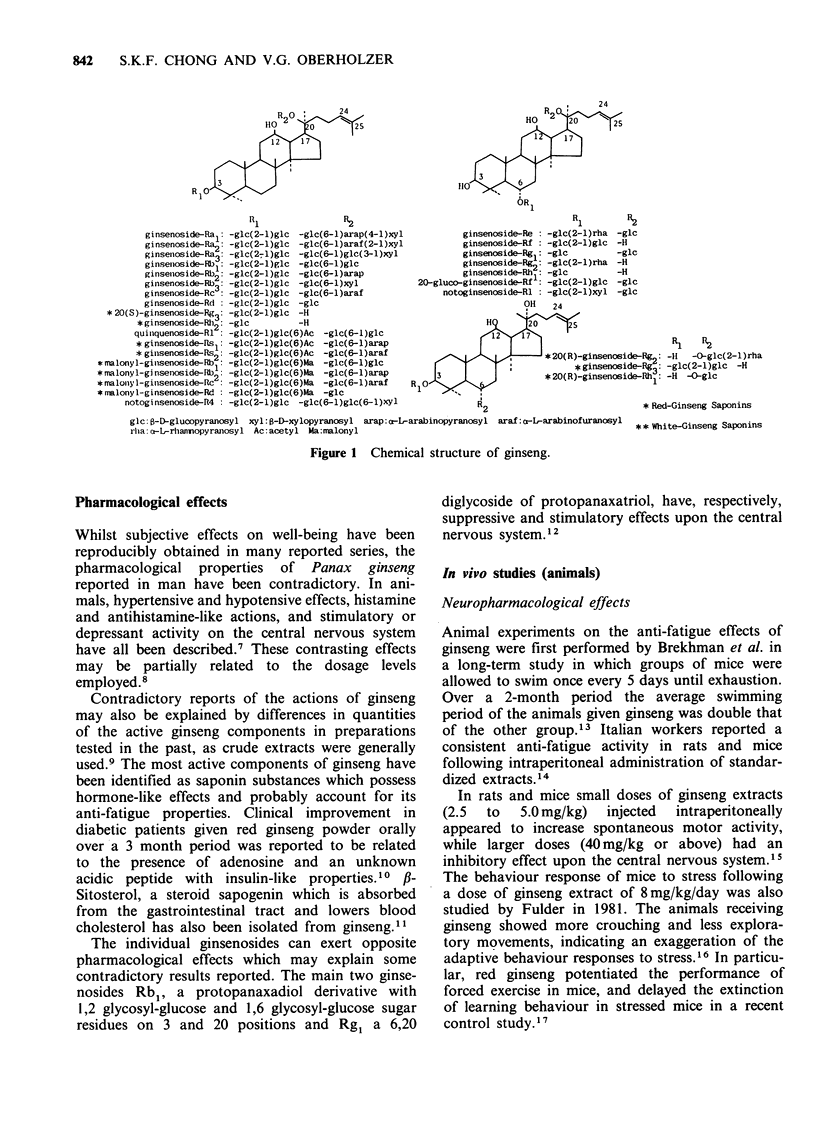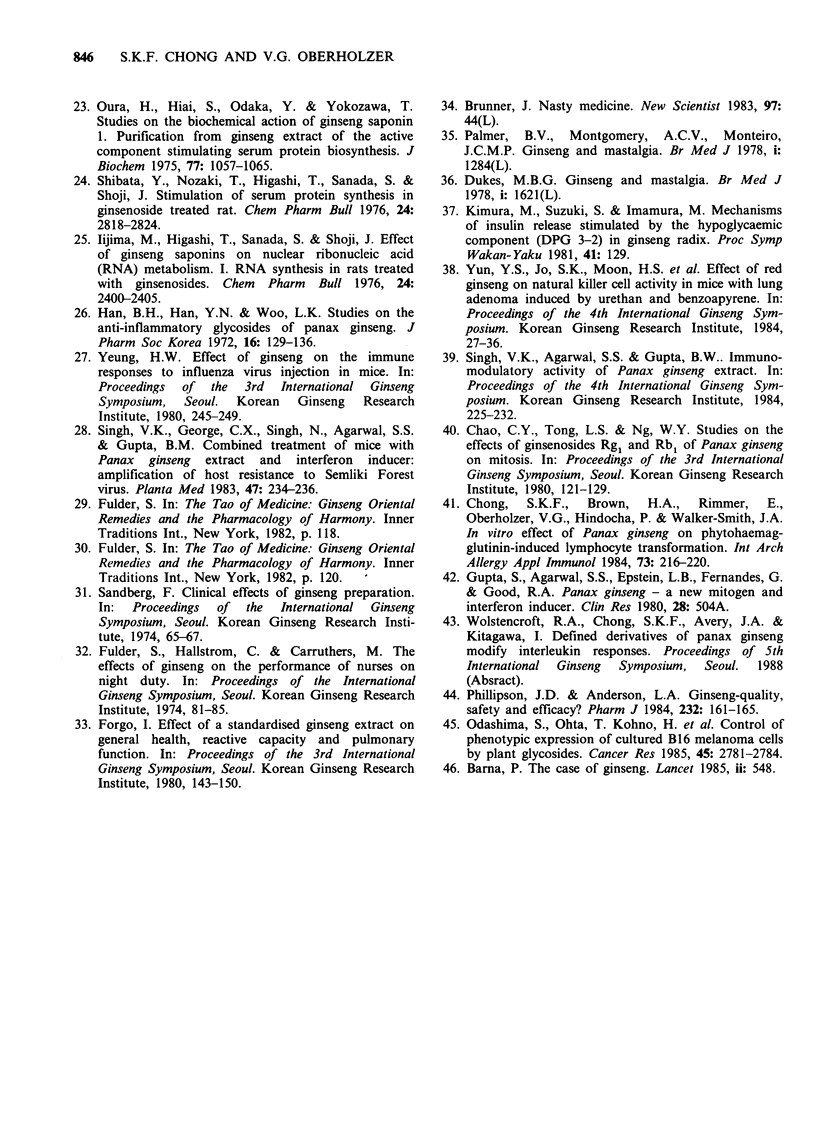Abstract
Panax ginseng occupies an important place among the tonic remedies of Oriental medicine. Pharmacological investigations show that crude ginsenosides can increase non-specific resistance of an organism to various untoward influences. The effects of purified derived derivatives have only recently become better studied in immunological and cell growth studies in animals and in man. This has now provided some evidence to suggest that ginseng is a drug that contains many derivatives with different pharmacological properties, which could be useful in clinical medicine.
Full text
PDF





Selected References
These references are in PubMed. This may not be the complete list of references from this article.
- Ando T., Muraoka T., Yamasaki N., Okuda H. Preparation of anti-lipolytic substance from Panax ginseng. Planta Med. 1980 Jan;38(1):18–23. doi: 10.1055/s-2008-1074832. [DOI] [PubMed] [Google Scholar]
- Barna P. The case of ginseng. Lancet. 1985 Sep 7;2(8454):548–548. doi: 10.1016/s0140-6736(85)90476-3. [DOI] [PubMed] [Google Scholar]
- Brekhman I. I., Dardymov I. V. New substances of plant origin which increase nonspecific resistance. Annu Rev Pharmacol. 1969;9:419–430. doi: 10.1146/annurev.pa.09.040169.002223. [DOI] [PubMed] [Google Scholar]
- Chong S. K., Brown H. A., Rimmer E., Oberholzer V., Hindocha P., Walker-Smith J. A. In vitro effect of Panax ginseng on phytohaemagglutinin-induced lymphocyte transformation. Int Arch Allergy Appl Immunol. 1984;73(3):216–220. doi: 10.1159/000233470. [DOI] [PubMed] [Google Scholar]
- Dukes M. N. Ginseng and mastalgia. Br Med J. 1978 Jun 17;1(6127):1621–1621. doi: 10.1136/bmj.1.6127.1621-a. [DOI] [PMC free article] [PubMed] [Google Scholar]
- Fulder S. J. Ginseng and the hypothalamic-pituitary control of stress. Am J Chin Med. 1981 Summer;9(2):112–118. doi: 10.1142/s0192415x81000159. [DOI] [PubMed] [Google Scholar]
- HOERHAMMER L., WAGNER H., LAY B. [On determination of the contents of radix Panax ginseng C. A. Meyer. (Preliminary report)]. Pharm Zentralhalle Dtschl. 1961 Oct 19;106:1307–1311. [PubMed] [Google Scholar]
- Hiai S., Yokoyama H., Oura H. Features of ginseng saponin-induced corticosterone secretion. Endocrinol Jpn. 1979 Dec;26(6):737–740. doi: 10.1507/endocrj1954.26.737. [DOI] [PubMed] [Google Scholar]
- Hiai S., Yokoyama H., Oura H., Yano S. Stimulation of pituitary-adrenocortical system by ginseng saponin. Endocrinol Jpn. 1979 Dec;26(6):661–665. doi: 10.1507/endocrj1954.26.661. [DOI] [PubMed] [Google Scholar]
- Iijima M., Higashi T., Sanada S., Shoji J. Effect of ginseng saponins on nuclear ribonucleic acid (RNA) metabolism. I. RNA synthesis in rats treated with ginsenosides. Chem Pharm Bull (Tokyo) 1976 Oct;24(10):2400–2405. doi: 10.1248/cpb.24.2400. [DOI] [PubMed] [Google Scholar]
- Kimura M., Waki I., Chujo T., Kikuchi T., Hiyama C., Yamazaki K., Tanaka O. Effects of hypoglycemic components in ginseng radix on blood insulin level in alloxan diabetic mice and on insulin release from perfused rat pancreas. J Pharmacobiodyn. 1981 Jun;4(6):410–417. doi: 10.1248/bpb1978.4.410. [DOI] [PubMed] [Google Scholar]
- Kitagawa I., Yoshikawa M., Yoshihara M., Hayashi T., Taniyama T. [Chemical studies of crude drugs (1). Constituents of Ginseng radix rubra]. Yakugaku Zasshi. 1983 Jun;103(6):612–622. [PubMed] [Google Scholar]
- Odashima S., Ohta T., Kohno H., Matsuda T., Kitagawa I., Abe H., Arichi S. Control of phenotypic expression of cultured B16 melanoma cells by plant glycosides. Cancer Res. 1985 Jun;45(6):2781–2784. [PubMed] [Google Scholar]
- Oura H., Hiai S., Odaka Y., Yokozawa T. Studies on the biochemical action of ginseng saponin. I. Purification from ginseng extract of the active component stimulating serum protein biosynthesis. J Biochem. 1975 May;77(5):1057–1065. doi: 10.1093/oxfordjournals.jbchem.a130806. [DOI] [PubMed] [Google Scholar]
- Palmer B. V., Montgomery A. C., Monteiro J. C. Gin Seng and mastalgia. Br Med J. 1978 May 13;1(6122):1284–1284. doi: 10.1136/bmj.1.6122.1284. [DOI] [PMC free article] [PubMed] [Google Scholar]
- Punnonen R., Lukola A. Oestrogen-like effect of ginseng. Br Med J. 1980 Oct 25;281(6248):1110–1110. doi: 10.1136/bmj.281.6248.1110. [DOI] [PMC free article] [PubMed] [Google Scholar]
- SHIBATA S., FUJITA M., ITOKAWA H., TANAKA O., ISHII T. STUDIES ON THE CONSTITUENTS OF JAPANESE AND CHINESE CRUDE DRUGS. XI. PANAXADIOL, A SAPOGENIN OF GINSENG ROOTS. Chem Pharm Bull (Tokyo) 1963 Jun;11:759–761. doi: 10.1248/cpb.11.759. [DOI] [PubMed] [Google Scholar]
- Shibata Y., Nozaki T., Higashi T., Sanada S., Shoji J. Stimulation of serum protein synthesis in ginsenoside treated rat. Chem Pharm Bull (Tokyo) 1976 Nov;24(11):2818–2824. doi: 10.1248/cpb.24.2818. [DOI] [PubMed] [Google Scholar]
- Siegel R. K. Ginseng abuse syndrome. Problems with the panacea. JAMA. 1979 Apr 13;241(15):1614–1615. [PubMed] [Google Scholar]
- Singh V. K., George C. X., Singh N., Agarwal S. S., Gupta B. M. Combined treatment of mice with Panax ginseng extract and interferon inducer. Amplification of host resistance to Semliki forest virus. Planta Med. 1983 Apr;47(4):234–236. doi: 10.1055/s-2007-969995. [DOI] [PubMed] [Google Scholar]
- Soldati F., Sticher O. HPLC separation and quantitative determination of ginsenosides from Panax ginseng, Panax quinquefolium and from ginseng drug preparations. 2nd communication. Planta Med. 1980 Aug;39(4):348–357. doi: 10.1055/s-2008-1074929. [DOI] [PubMed] [Google Scholar]
- Takagi K., Saito H., Nabata H. Pharmacological studies of Panax ginseng root: estimation of pharmacological actions of Panax ginseng root. Jpn J Pharmacol. 1972 Apr;22(2):245–249. doi: 10.1254/jjp.22.245. [DOI] [PubMed] [Google Scholar]


